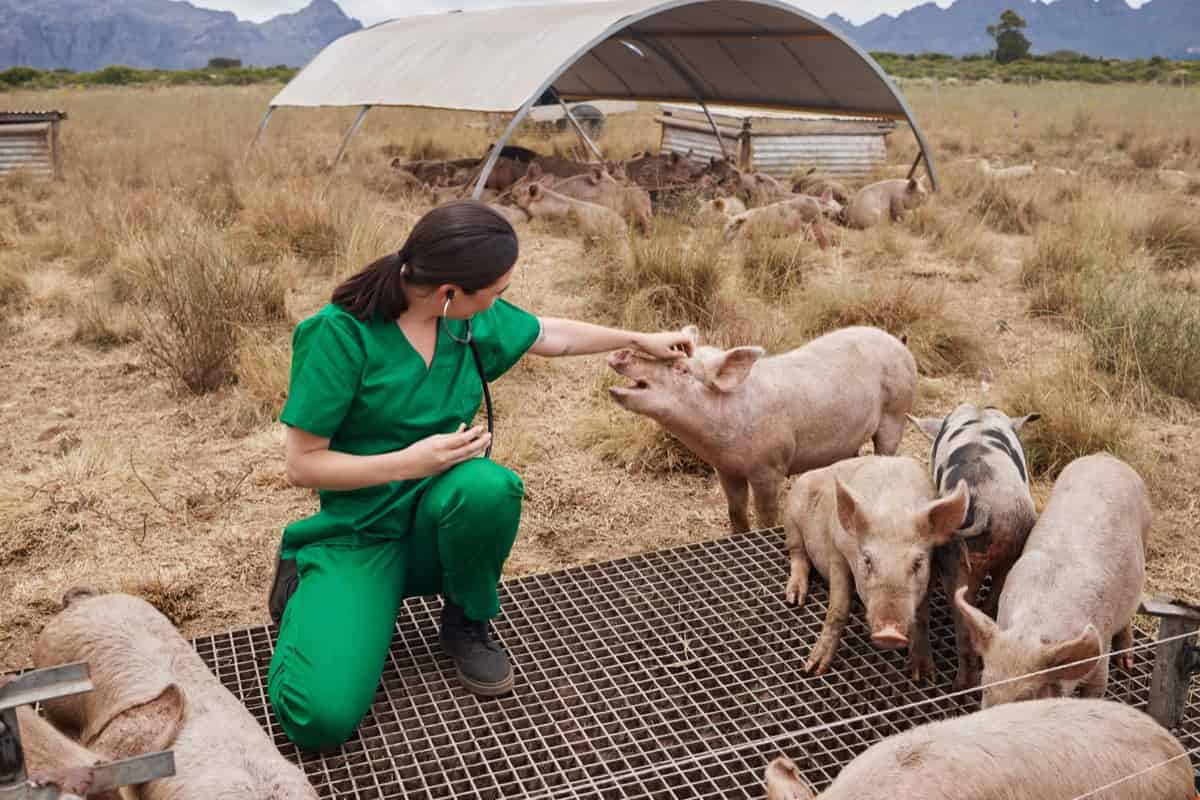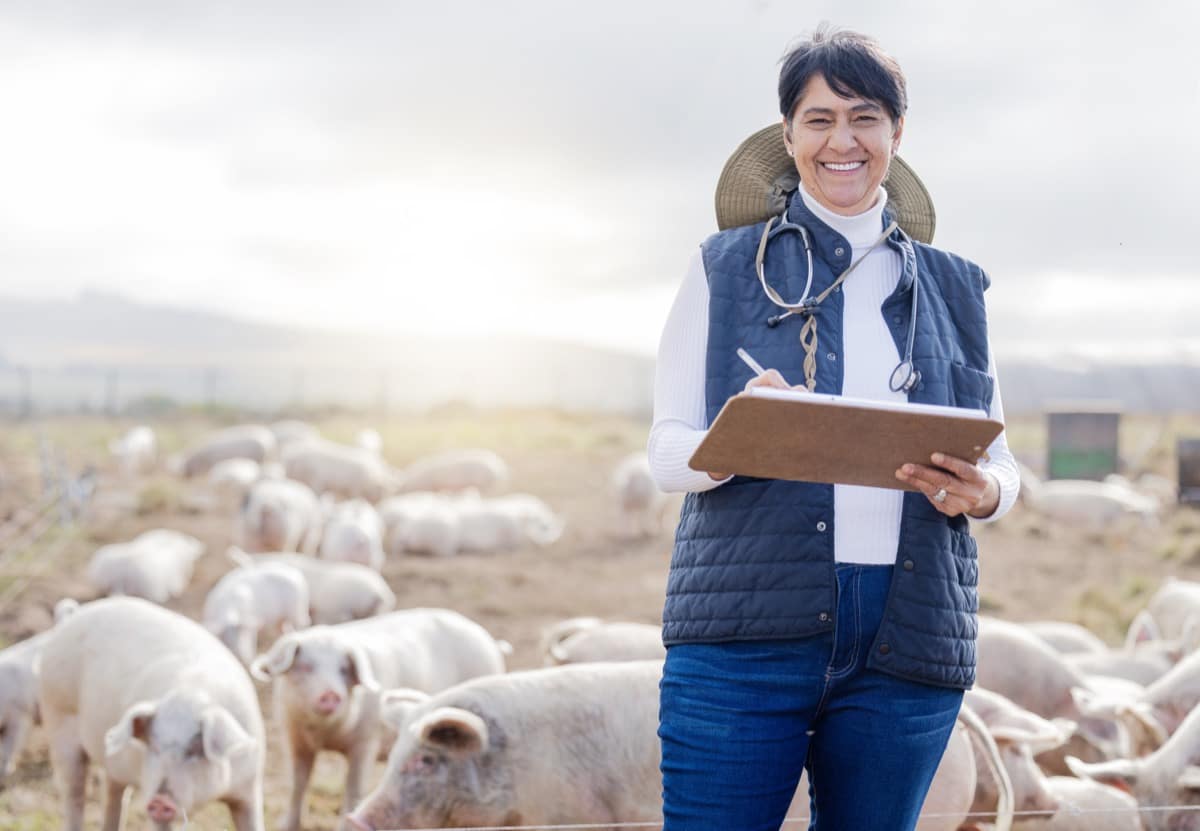In pig farming, respiratory disease is a frequent and severe problem that results in significant financial losses and raises questions about animal welfare. Pigs’ complex respiratory systems can be impacted by a number of variables, which increases their susceptibility to infections. Viruses, bacteria, other infectious agents, and environmental variables like inadequate ventilation, temperature swings, and elevated levels of dust or ammonia can all contribute to the development of respiratory diseases.

Primary and opportunistic bacteria found in the upper respiratory tract of healthy piglets are frequently a contributing factor in respiratory disease in pigs. When viruses are also present, the term porcine respiratory disease complex (PRDC) is used instead of swine respiratory disease (SRD), which describes respiratory illness brought on solely by germs. Opportunistic bacteria can cause illness due to immune system dysfunction, which frequently results in more serious lung diseases.
Multiple individuals infected simultaneously can make things worse. The name PRDC emphasizes the complexity of events that take place during the progression of pneumonia in pigs. To stop the proliferation of respiratory diseases and reduce their negative effects on the economy and animal welfare, it is essential to identify and treat them as soon as possible.
The incidence and severity of respiratory diseases in pig populations can greatly decrease using appropriate management techniques, including biosecurity precautions and vaccination programs. According to research, respiratory diseases account for up to 75% of all swine fatalities following weaning. The swine business suffers losses as a result.
Respiratory Disease Management in Pig/Swine
Causes of Respiratory Disease in Pig/Swine
Various factors, including infectious agents, environmental conditions, and management practices, can cause respiratory diseases in pigs. Bacterial agents such as Pasteurella multocida, Actinobacillus pleuropneumonia, and Mycoplasma hyopneumoniae are among the most common culprits of respiratory infections in pigs.
Viruses such as the swine influenza virus and Porcine Reproductive and Respiratory Syndrome Virus also contribute to respiratory disease outbreaks in pigs. Poor ventilation, overcrowding, and inadequate temperature control can exacerbate respiratory disease problems, as can exposure to toxic gases such as ammonia and dust particles.
Disease Cycle of Respiratory Disease
Respiratory diseases in pigs have a cycle that perpetuates the spread of the disease. It begins with introducing the pathogen into the herd, which can occur through multiple routes, such as direct contact with an infected animal, contaminated feed or water, or exposure to aerosols carrying the pathogen. Once the pathogen enters the pig, it replicates, leading to infection and the onset of clinical signs. Infected pigs then shed the pathogen through their respiratory secretions, feces, and urine, which can contaminate the environment and infect other pigs.
What are the Symptoms of Respiratory Disease?
- Coughing
- Sneezing
- Rapid breathing
- Labored breathing
- Nasal discharge
- Eye discharge
- Loss of appetite
- Fever (above 39.4°C or 103°F)
- Lethargy
- Reduced growth rate
In case you missed it: Exudative Dermatitis (Greasy Pig Disease) Management in Pig/Swine: Symptoms, Treatment, and Prevention

Diagnosis for Respiratory Disease in Pig/Swine
Since different pathogens can get involved and the clinical signs can change depending on the disease, diagnosing respiratory diseases in pigs can be difficult. To formally establish a diagnosis, clinical signs, necropsy results, and laboratory studies are required. Typical diagnostic procedures include bacterial culture, polymerase chain reaction (PCR), serology, and histopathology.
Swabs from the tonsils, lungs, and nasal passageways can be taken for bacterial culture and PCR testing. It is possible to find antibodies to particular organisms using serology. Examining tissue samples for tumors and inflammatory changes is part of histopathology. For proper treatment and disease control methods, an accurate diagnosis is essential.
Treatment and Control of Respiratory Diseases in Pig/Swine
Treatment
- Antibiotics can be given in feed, water, or as an injectable, depending on the cause of the respiratory disease.
- Supportive care such as good nutrition and proper ventilation can help pigs recover from respiratory disease.
Control
- Vaccines are available for some forms of pneumonia and other respiratory diseases, but the strain affecting a specific farm should be identified to ensure the vaccine is effective.
- Proper biosecurity measures, such as preventing the introduction of new animals to the herd and maintaining hygiene, can help prevent respiratory disease outbreaks.
- Regular monitoring and testing for respiratory diseases can help detect and control outbreaks early.
Preventive and Management Measures to Control Respiratory Disease
- Biosecurity precautions include ensuring a farm’s safety from the introduction and spread of infectious agents.
- Vaccines are available for some strains to stop the proliferation of respiratory diseases in pigs.
- Appropriate ventilation: Adequate ventilation is necessary to lessen the number of airborne germs and to support healthy lungs.
- Keeping the pigs’ housing dry and tidy is an important hygiene practice that can help prevent respiratory infections.
- Proper nutrition is essential for a healthy immune system, and a varied diet can reduce the risk of respiratory illnesses.
- The prevention and treatment of respiratory diseases in swine depend on one factor above all others: temperature.
- Consistent checks for respiratory symptoms in pigs can help identify and treat infections early, limiting the spread of disease.
Vaccination for Respiratory Disease in Pig/Swine
Vaccines are available for some forms of respiratory disease in pigs, including pneumonia. However, it is important to identify the specific strain of bacteria causing the disease to ensure that the appropriate vaccine is used. Vaccination can be an effective tool for preventing respiratory disease. Still, it should be part of a comprehensive management plan that includes good hygiene, proper ventilation, and appropriate stocking density. If you need to learn how to vaccinate your herd best, getting advice from a doctor is best.
Impact of Respiratory Disease
Pig farmers around the globe worry a lot about respiratory diseases because they can significantly impact the health of the animals, the effectiveness of their production, and their profitability. Due to their ability to slow growth and increase mortality rates, respiratory conditions can result in fiscal losses.
They may also result in increased antibiotic usage, which is detrimental to the general populace because it strengthens bacteria’s resistance to medicines. Furthermore, the increased use of manure and the disposal of dead animals can damage the environment due to respiratory diseases.
In case you missed it: Management of Aphids in Spinach: Symptoms, Treatment, Chemical, Biological, Natural, and Organic Control

Conclusion
Respiratory disease in pigs is a complex issue caused by poor ventilation, overcrowding, and infective agents. Identifying and addressing the root cause is crucial for effective prevention and treatment. Vaccination, proper hygiene, and good management practices can help control respiratory disease in pigs and minimize the negative impact on pig health and production.
- Beneficial Insects in Pest Management
- Natural Solutions for Pest Control in Flower Gardens
- Types of Fungicides Used in Agriculture
- Common Issues in the Fruit Development Stage of Pomegranate Farming
- Fruit Development Issues in Papaya: Easy Solutions and Treatment
- Soil-Borne Diseases and How to Protect Your Plants
- Practices to Prevent Disease Spread in the Garden
- From Wilted to Thriving: How to Treat Root Rot Naturally in Houseplants
- Natural Remedies to Cure Brown Spots on Fig Tree Leaves